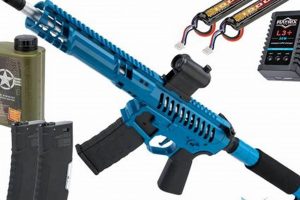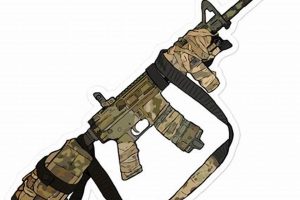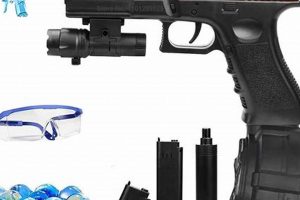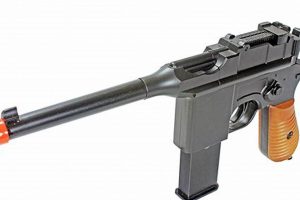The question of whether simulated firearms present an acceptable level of risk for pre-adolescents is a complex one. It necessitates consideration of the inherent dangers associated with projectile-based toys, the maturity level of the user, and the implementation of appropriate safety measures.
Engaging in simulated combat activities can provide opportunities for developing teamwork, strategic thinking, and physical exercise. Historically, such activities were less regulated; however, increasing awareness of potential hazards has led to stricter guidelines and recommendations regarding their use, particularly concerning younger participants.
This discussion will examine the factors contributing to safe usage, including protective gear requirements, responsible handling practices, parental supervision, and age-appropriate game scenarios. It will also address the potential physical and psychological implications for children in this age group.
Safety Guidelines for Pre-Adolescent Airsoft Participation
The following recommendations are intended to minimize risks associated with simulated firearm activities involving individuals aged eleven years old. Strict adherence to these guidelines is crucial for responsible participation.
Tip 1: Mandatory Protective Gear: Full-face protection, including goggles specifically designed for airsoft, is non-negotiable. Eye injuries are a primary concern and are preventable with proper equipment. The chosen gear must meet or exceed ANSI Z87.1 standards.
Tip 2: Adult Supervision is Essential: An informed and responsible adult must directly supervise all airsoft activities involving children. This adult should be knowledgeable about airsoft safety protocols and capable of enforcing rules.
Tip 3: Age-Appropriate Game Play: Modify game scenarios to suit the maturity and physical capabilities of young participants. Reduce engagement distances, lower projectile velocities, and implement simplified rules to minimize potential for injury or overly aggressive behavior.
Tip 4: Gun Safety Education: Prior to engaging in any activity, participants must receive thorough instruction on safe gun handling practices. This includes proper aiming, trigger discipline, and muzzle control. All participants should understand that simulated firearms are never to be pointed at anyone who is not participating in the game.
Tip 5: Velocity Restrictions: Enforce strict velocity limits on airsoft projectiles. A chronograph should be used to verify that all airsoft guns adhere to pre-determined velocity limits established for youth players. Lower velocities significantly reduce the potential for injury.
Tip 6: Safe Zones and No-Shoot Rules: Establish designated safe zones where airsoft guns are strictly prohibited from being fired. Reinforce the importance of respecting these areas to prevent accidental discharges and ensure participant safety.
Tip 7: Limited Engagement Distances: Implement minimum engagement distances to prevent close-range impacts, which can result in bruising or welts. Participants should be taught to shout “Cease Fire” if another player gets within the minimum engagement distance.
By diligently applying these safety precautions, the risks related to engaging in simulated firearm activities are greatly reduced, and the probability of a positive experience for all participants is increased. Parental awareness and proactive enforcement of safety rules are paramount.
The subsequent section will address the psychological considerations and potential long-term impacts associated with pre-adolescent participation in these activities.
1. Supervision
Effective oversight forms a cornerstone in the assessment of whether simulated firearms can be considered appropriately safe for eleven-year-olds. The presence, quality, and scope of supervision directly influence the potential for both accidental injuries and the development of responsible handling habits.
- Direct Oversight and Intervention
Active monitoring allows for immediate intervention in situations involving unsafe practices, such as improper aiming or disregard for safety zones. For example, a supervisor can quickly correct a child who unintentionally points a simulated firearm in an unsafe direction, preventing a potential accident. Consistent intervention reinforces the importance of adhering to safety protocols.
- Rule Enforcement and Compliance
Supervision ensures adherence to established rules and regulations governing airsoft activities. This includes enforcing minimum engagement distances, velocity limits, and the mandatory use of protective gear. A supervisor can verify compliance by checking equipment and monitoring player behavior, contributing to a safer environment.
- Instruction and Guidance
Supervisors provide ongoing instruction and guidance on safe handling practices, reinforcing initial training and addressing emerging questions. This includes clarifying rules, demonstrating proper techniques, and providing feedback on player performance. This reinforces safety education and responsible attitudes.
- Conflict Resolution and Emotional Regulation
Adult supervision facilitates conflict resolution and assists in managing the emotional responses of participants. Disputes arising during gameplay can be addressed promptly and fairly, preventing escalation and promoting a positive experience. Supervisors can also intervene if a child becomes overly aggressive or frustrated, ensuring that gameplay remains controlled and respectful.
The multifaceted nature of supervision establishes a critical safety net for pre-adolescents engaging in simulated firearm activities. The absence of adequate supervision significantly elevates the risk profile, emphasizing the necessity of responsible adult involvement to mitigate potential hazards.
2. Protective Gear
The safety of pre-adolescents engaging in simulated firearm activities is inextricably linked to the consistent and correct use of appropriate protective gear. The high-velocity projectiles used in airsoft present a tangible risk of injury, particularly to vulnerable areas such as the eyes, face, and teeth. Protective equipment acts as a crucial barrier, mitigating the impact of these projectiles and reducing the likelihood of serious harm. For instance, professionally-designed airsoft goggles, meeting specific impact-resistance standards, can prevent potentially blinding eye injuries. Similarly, full-face masks offer protection against facial lacerations and dental damage.
The implementation of protective gear requirements is not merely a suggestion, but a necessity. Consider a scenario where an eleven-year-old is struck in the face by a projectile during an airsoft game without a face mask. The potential for severe injury, including broken teeth and facial scarring, is substantial. Conversely, if the participant is wearing a properly fitted and certified face mask, the impact force is distributed, minimizing the risk of significant damage. Furthermore, requiring protective gear also reinforces a culture of safety and responsibility among participants, promoting awareness of the inherent risks involved and the importance of minimizing those risks.
Therefore, the utilization of appropriate protective gear is not simply an accessory; it forms an integral component of any responsible approach to simulated firearm activities involving young individuals. Without consistent use of adequately rated protective equipment, the risks associated with airsoft are significantly amplified, rendering the activity inherently unsuitable for pre-adolescents. Consistent application, maintenance and oversight of proper gear are vital to ensuring the safety of the user.
3. Velocity Limits
Velocity limits are a critical parameter in determining the safety profile of airsoft activities, particularly when considering the suitability for pre-adolescents. The kinetic energy of an airsoft projectile, directly proportional to its velocity, dictates the potential for causing injury upon impact. Therefore, establishing and enforcing appropriate velocity limits is paramount in minimizing risks associated with this activity.
- Reduced Impact Force
Lowering the velocity of airsoft projectiles translates directly to a reduction in the force of impact. This lessened impact diminishes the likelihood of injuries such as bruising, welts, and eye damage. For example, a projectile traveling at 300 feet per second (fps) imparts significantly less force than one traveling at 400 fps, thereby reducing the risk of harm to a child’s still-developing tissues.
- Minimum Engagement Distance Correlation
Velocity limits are often correlated with minimum engagement distances. Lower velocities permit closer engagement ranges, while higher velocities necessitate greater separation to mitigate impact risks. Maintaining a balance between projectile velocity and engagement distance ensures that participants are not subjected to excessive force, even at close range.
- Regulatory Compliance and Standardization
Many organized airsoft events and fields mandate adherence to specific velocity limits, often differentiated by age group or role. Compliance with these standards provides a baseline level of safety and ensures that participants are not exposed to excessive projectile speeds. For instance, some jurisdictions may limit velocities to 350 fps for players under 16 years of age, reflecting a heightened concern for their well-being.
- Gun Modification Restrictions
Enforcement of velocity limits often necessitates restrictions on airsoft gun modifications. Modifications that increase projectile velocity beyond established thresholds are typically prohibited, as they compromise the safety of all participants. Regular chronograph testing is crucial to verify that airsoft guns adhere to specified velocity limits and that unauthorized modifications have not been implemented.
In summation, the establishment and rigorous enforcement of appropriate velocity limits constitute a vital component in assessing whether simulated firearm activities are acceptably safe for eleven-year-olds. By mitigating impact forces, correlating with engagement distances, promoting regulatory compliance, and restricting gun modifications, velocity limits contribute significantly to minimizing risks and fostering a safer environment for young participants.
4. Maturity Level
The cognitive and emotional maturity of an eleven-year-old directly influences the degree of risk associated with simulated firearm activities. An individual’s maturity level impacts their ability to understand and adhere to safety protocols, control impulses, and make responsible decisions in dynamic environments. This consideration is paramount when assessing the overall safety profile of airsoft participation.
- Comprehension of Safety Rules
A mature individual demonstrates the capacity to fully grasp and internalize complex safety rules and regulations. This includes understanding the importance of protective gear, velocity limits, safe zones, and minimum engagement distances. For instance, a more mature eleven-year-old is less likely to disregard safety instructions or engage in risky behavior due to a clearer comprehension of the potential consequences. Conversely, a less mature individual may struggle to comprehend the nuances of safety protocols, leading to unintentional rule violations and increased risk.
- Impulse Control and Emotional Regulation
Engaging in simulated combat scenarios can be emotionally stimulating, requiring participants to exercise impulse control and regulate their emotional responses. A mature individual can manage impulses to act recklessly or aggressively, maintaining a calm and rational demeanor even in high-pressure situations. Conversely, a less mature individual may exhibit impulsive behavior or struggle to control emotions, potentially leading to unsafe actions such as firing recklessly or engaging in unsportsmanlike conduct, increasing the risk of accidents or injuries.
- Responsibility and Accountability
Mature individuals demonstrate a sense of responsibility and accountability for their actions. They accept ownership of their behavior and are willing to take corrective action when necessary. In the context of airsoft, this translates to responsibly handling simulated firearms, adhering to safety protocols, and promptly reporting any incidents or concerns. A less mature individual may exhibit a lack of responsibility, failing to properly care for equipment, disregarding safety rules, or shirking accountability for their actions, thereby increasing the risk of accidents or injuries.
- Decision-Making Under Pressure
Simulated firearm activities often require participants to make quick decisions under pressure. A mature individual can assess risks, weigh options, and make sound judgments even in dynamic and challenging situations. This includes making appropriate tactical decisions, prioritizing safety, and avoiding unnecessary risks. A less mature individual may struggle to make sound decisions under pressure, potentially leading to poor judgment, increased risk-taking, and a higher likelihood of accidents or injuries.
The interconnected facets of comprehension, impulse control, responsibility, and decision-making skills collectively define an individual’s maturity level and its impact on the safety of airsoft participation. When assessing “are airsoft guns safe for 11 year olds,” the presence of these elements suggests a higher likelihood of responsible and safe engagement, while their absence indicates a heightened risk profile. An accurate appraisal of a child’s maturity is essential for determining their readiness for simulated firearm activities.
5. Environment
The physical environment in which airsoft activities occur is a primary determinant of safety, especially for participants aged eleven. The characteristics of the surroundings directly influence the potential for accidents and injuries. A controlled, purpose-built airsoft field with designated safe zones, clear boundaries, and hazard mitigation measures offers a significantly safer environment than an uncontrolled, unregulated area such as a backyard or public park. For instance, a field free from obstacles like exposed tree roots or sharp debris reduces the risk of trips and falls, while clearly marked boundaries prevent unintended trespassing onto neighboring properties.
Furthermore, the social environment plays a crucial role. A well-managed airsoft field with experienced referees ensures that rules are consistently enforced, promoting fair play and minimizing aggressive behavior. Conversely, a setting where rules are lax or non-existent can foster a culture of disregard for safety, leading to increased risk-taking and potential harm. For example, if referees consistently penalize players who violate minimum engagement distances, participants are more likely to adhere to this rule, reducing the risk of close-range impacts. Similarly, a social environment that emphasizes sportsmanship and respect discourages aggressive or retaliatory actions, contributing to a safer and more positive experience. The existence of readily available first-aid resources and personnel is also crucial.
In summary, the physical and social environments are indispensable components in evaluating whether simulated firearm activities present an acceptable level of risk for pre-adolescents. A safe and controlled environment, characterized by hazard mitigation, rule enforcement, and a culture of sportsmanship, significantly reduces the potential for accidents and injuries. Therefore, the selection of an appropriate environment is paramount when considering “are airsoft guns safe for 11 year olds,” and must be carefully weighed against the potential hazards associated with unregulated settings.
6. Education
The question of whether simulated firearms can be considered appropriately safe for pre-adolescents is directly and significantly influenced by the quality and extent of safety education provided. Comprehensive education serves as a foundational element, equipping young participants with the knowledge and skills necessary to mitigate risks associated with airsoft activities. A lack of adequate instruction significantly elevates the potential for accidents and injuries, rendering participation demonstrably less safe.
Effective education programs encompass several key areas. Firstly, participants must receive thorough instruction on the safe handling of simulated firearms, including proper aiming techniques, trigger discipline, and muzzle control. Secondly, comprehensive coverage of protective gear requirements is vital, ensuring participants understand the importance of wearing appropriate equipment and how to properly maintain it. Thirdly, education on velocity limits and minimum engagement distances is crucial, providing participants with a clear understanding of these parameters and their impact on safety. For instance, a participant who has been adequately educated on the dangers of close-range impacts is more likely to maintain a safe distance from other players, reducing the risk of injury. Finally, education should extend to the rules of engagement, fair play, and responsible behavior, fostering a culture of respect and sportsmanship. In real-world scenarios, airsoft fields with mandatory safety briefings and regular refresher courses consistently report lower incident rates compared to environments where safety education is lacking.
In conclusion, education stands as a critical determinant of the safety of simulated firearm activities for pre-adolescents. Comprehensive instruction empowers young participants to make informed decisions, mitigate risks, and engage responsibly. The absence of adequate education significantly compromises the safety profile of airsoft, highlighting the necessity of prioritizing safety education as an indispensable component of any program involving young individuals. Parental involvement in reinforcing safety protocols is equally important, augmenting formal education and ensuring consistent application of safe practices. The ongoing nature of this education ensures that it remains effective and relevant to changing circumstances.
Frequently Asked Questions
This section addresses common inquiries regarding the safety of simulated firearm activities for individuals aged eleven years.
Question 1: Are airsoft guns safe for 11 year olds?
The safety of airsoft guns for individuals in this age group depends significantly on adherence to strict safety protocols, including mandatory protective gear, adult supervision, controlled environments, and comprehensive safety education. Without these precautions, the risk of injury is substantially increased.
Question 2: What type of protective gear is required for pre-adolescent airsoft participants?
Full-face protection, including goggles that meet or exceed ANSI Z87.1 standards, is mandatory. Additional protective gear, such as face masks, vests, and gloves, is also recommended to mitigate the risk of injuries from projectile impacts.
Question 3: What level of adult supervision is necessary for airsoft activities involving eleven-year-olds?
Direct and constant adult supervision by a knowledgeable and responsible individual is essential. The supervising adult must be capable of enforcing safety rules, providing guidance, and intervening in unsafe situations.
Question 4: What velocity limits should be enforced for airsoft guns used by pre-adolescents?
Velocity limits should be strictly enforced and calibrated to the age and maturity level of the participants. Lower velocity limits, typically below 350 feet per second, are recommended for eleven-year-olds to minimize the impact force of projectiles.
Question 5: How does the playing environment impact the safety of airsoft activities for young participants?
A controlled and regulated environment, such as a purpose-built airsoft field with designated safe zones and clear boundaries, is crucial. Uncontrolled environments, such as backyards or public parks, present significantly greater risks.
Question 6: What key elements should be included in safety education programs for pre-adolescent airsoft participants?
Safety education programs must include comprehensive instruction on safe gun handling, protective gear requirements, velocity limits, minimum engagement distances, rules of engagement, fair play, and responsible behavior.
Adherence to these guidelines significantly mitigates the potential risks associated with these activities and are critical if you plan to include an eleven-year-old.
The subsequent section will explore alternative activities offering similar benefits with potentially lower risk profiles.
Are Airsoft Guns Safe for 11 Year Olds
The preceding analysis has demonstrated that the question of “are airsoft guns safe for 11 year olds” cannot be answered with a simple affirmative. Instead, the assessment necessitates careful consideration of numerous interconnected factors. Stringent adherence to safety protocols, including mandatory protective gear, consistent adult supervision, environment oversight, strict velocity limits, and comprehensive safety education, is paramount in mitigating the inherent risks associated with projectile-based activities. A failure to rigorously implement and enforce these measures substantially elevates the potential for injury, thereby rendering the activity unsuitable for this age group.
Ultimately, the decision of whether to permit an eleven-year-old to participate in simulated firearm activities requires careful deliberation and a thorough evaluation of the individual child’s maturity, the availability of appropriate safety measures, and the commitment of responsible adults to ensure strict adherence to established protocols. A conservative approach, prioritizing safety above all else, is warranted when considering activities with inherent risk factors for pre-adolescents. The potential for physical and psychological harm, however minimal when all precautions are taken, must be weighed against the perceived benefits of participation. This careful balancing act should serve to guide and lead to the proper decision.







